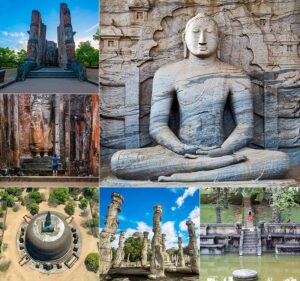Polonnaruwa: The Ancient Capital of Sri Lanka’s Cultural Heritage
 Nestled in the heart of Sri Lanka’s Cultural Triangle, Polonnaruwa is a city that whispers tales of grandeur from a bygone era. This UNESCO World Heritage Site, once the flourishing capital of the island, is now a historical treasure trove awaiting exploration by travelers seeking a glimpse into Sri Lanka’s illustrious past.
Nestled in the heart of Sri Lanka’s Cultural Triangle, Polonnaruwa is a city that whispers tales of grandeur from a bygone era. This UNESCO World Heritage Site, once the flourishing capital of the island, is now a historical treasure trove awaiting exploration by travelers seeking a glimpse into Sri Lanka’s illustrious past.
A Historical Overview:
Polonnaruwa’s history dates back to the 12th century when it became the second capital of ancient Sri Lanka after the fall of Anuradhapura. During the reign of King Parakramabahu I, it flourished as a thriving city adorned with remarkable architecture and a complex irrigation system that still amazes historians and engineers today.
Architectural Wonders:
- Parakrama Samudraya (Sea of Parakrama): This colossal reservoir, built by King Parakramabahu I, stands as a testament to ancient engineering prowess. It’s an awe-inspiring sight and a testament to the city’s advanced hydraulic civilization.
- The Quadrangle: Within this sacred complex, you’ll find numerous temples, stupas, and statues that showcase the exquisite craftsmanship of the time. The Vatadage, a circular relic house, is a highlight.
- Gal Vihara: The Gal Vihara houses some of the island’s most iconic Buddha statues, carved from a single granite rock. These colossal sculptures exude serenity and are a testament to ancient sculpting skills.
- Polonnaruwa Vatadage: This circular relic house once enshrined the sacred Tooth Relic of the Buddha and stands as a masterpiece of ancient Sinhalese architecture.
Natural Beauty:
Polonnaruwa is not only a city of archaeological wonders but also a place of natural beauty. The archaeological park is surrounded by lush greenery and is home to an array of wildlife, including deer and monkeys. The scenic backdrop adds to the charm of exploring these ancient ruins.
Visiting Polonnaruwa:
- Attire: Visitors are expected to dress modestly, covering their shoulders and knees when entering temples and historical sites.
- Guided Tours: Engaging a knowledgeable local guide can enhance your experience by providing historical context and intriguing stories about the sites.
- Renting Bicycles: Many travelers opt to explore Polonnaruwa by bicycle, offering a convenient and eco-friendly way to navigate the sprawling archaeological park.
- Entrance Fees: There is an entrance fee to visit Polonnaruwa, and opening hours vary by site. Be sure to check the latest information before planning your visit.
Polonnaruwa beckons travelers to step into the past, walk in the footsteps of ancient kings, and to marvel at the architectural wonders that have withstood the test of time. It’s a journey through history and a celebration of Sri Lanka’s cultural heritage, making it a must-visit destination for those seeking to explore the island’s historical treasures.
Read more about this UNESCO site Polonnaruwa! Visit our Go Tours Lanka travel blog for updated details about when to visit etc.






